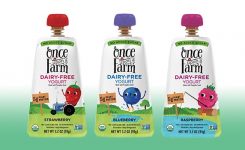Food, Products
Fishpeople CEO: ‘Seafood is stuck in the ’20s’
According to Nielsen data, average household penetration of seafood is 54% compared with other fresh food categories of meat (98%) and deli (99%).
The US is also the lowest consuming nation of seafood in world. While most of the world eats roughly 13.5 ounces per week, Americans are consuming just under five ounces per week (the FDA recommendation is eight to 12 ounces).
US seafood sales did increase this year by 3.4% in dollar sales for the 52 weeks ending Feb. 24, 2018 (10 days into Lent), Nielsen data found.
However, most of that increase is likely due to the 4.5% hike in average retail price of most fish, as volume sales were down 1.1% over the same period, Nielsen noted.
Fishpeople brings much-needed transparency to seafood
“Seafood is the last frontier in the consumer food revolution. Most other categories, including beef and chicken, we’ve seen those categories move toward the consumer, and seafood is stuck in the ’20s,” Fishpeople CEO Ken Plasse said at the recent ACG Conference in Chicago.
Fishpeople is a seafood company founded by Duncan Berry, a former commercial fisherman, and Kipp Baratoff, who worked previously in finance, green real estate, and natural resource management. The pair bonded over a concern for reviving North American coastal fisheries which have been historically overfished, with 90% of the caught fish shipped overseas.
Now a Certified B Corporation, Fishpeople is committed to harvesting only sustainable seafood species and keeping the value of seafood in local, US communities while using a hyper-transparent business model. Each seafood product comes with a traceable code that can be entered on the company’s website to reveal the origins of the product such as the exact location it came from and the individual who handled it.
Fishpeople sources its three main seafood varieties (wild albacore tuna, wild pacific cod, and wild Yukon River salmon) from coastal regions of Alaska, Oregon, and Washington. In the case of the Yukon River salmon, the local Yupik people of Western Alaska use dip nets to catch the salmon by hand along the 2,300 mile stretch of the Yukon River, this meticulous method also protects other salmon species while harvesting.
“There are incredible people in seafood that desperately want to get it right that are part of that bigger system… that means they’re handling it better on their boat,” Plasse said.
According to Plasse, these local fishermen have traditionally not received a premium for their painstaking fishing methods and the company’s light added bonus makes a huge difference in these networks of fishing communities while helping maintain the unique fish harvesting process.
Unease in the fish department
According to Plasse, two-thirds of seafood consumption takes place at restaurants because consumers “don’t trust their fish.”
“And let’s face it, the industry has had an incredibly spotty reputation that’s resulted in a massive breach of trust,” he said. “Frankly, it’s very well deserved.”
Ocean conservation group Oceana found that one in five seafood samples tested worldwide are fraudulently labeled. Most of the time, mislabeling involved consumers overpaying for a cheaper fish passed off as a pricier variety, but nearly 60% of mislabeled seafood pose a health risk to consumers, according to Oceana.
In its 2010 report, the Grocery Manufacturers Association estimated that Americans paid $15bn for fraudulently labeled seafood leading the Obama Administration to set up a specific Task Force to prevent further adulteration.
Another area of distrust in seafood comes from the use of FDA-approved STTP (sodium tripolyphosphate), a common preservative used in the industry that also does not have to be disclosed on the label.
“It (STPP) creates sheen, texture, and most of all, it bulks up water weight, and water’s money,” Plasse added.
“We have a lot of unethical and unsustainable fishing practices; we’ve gotten a lot better here and the US has some of the best in world, but we have a long way to go.”
Growth opportunities for seafood
Consumer education is a missing link for most seafood producers, particularly in the areas of sustainability and at-home meal preparation.
More consumers want to be sure that their food, including seafood, is responsibly sourced. Over the past year, sustainability claims increased 3%, seafood with Marine Stewardship Council (MSC) labeling grew 27%, and sales of seafood with Sustainable Fishing labeling grew 30%, according to Nielsen.
Many consumers are also concerned about seafood quality and freshness, while others are unsure about how to prepare the products at home.
“It’s smelly and messy, it’s difficult to prepare, and Americans don’t like difficult to prepare,” Plasse said.
Meal kits can be a useful strategy to increase household penetration of seafood, as 29% of meal kit users said they eat more seafood because of meal kits, Nielsen found.
Fishpeople products can be found in various meal kit services including Sun Basket and Gobble, in addition to the company’s own line of seafood kits designed to take the guesswork out of cooking with seafood entrées for two that can be prepared in 15 minutes using pre-measured ingredients and easy-to-follow instructions.
“Most people probably only have one recipe for salmon and you use it all the time because you’re sure it works. You’re probably afraid of undercooking it, so you’re overcooking it,” Plasse continued. “As a brand we want to solve the trust issue.”






